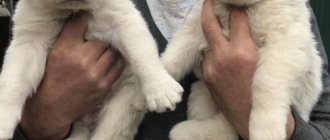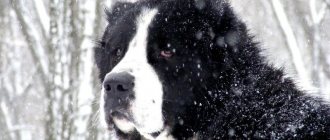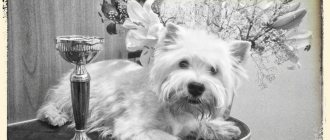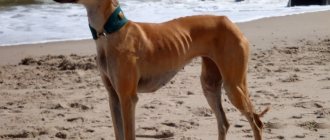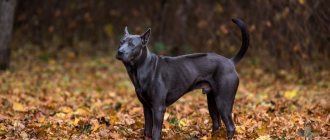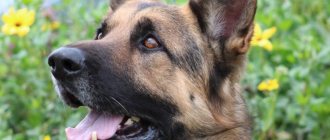Everyone who manages to meet this proud, exotic animal receives a powerful surge of positive emotions. The Thai Ridgeback is a representative of a valuable, rare breed. There are no more than 400 individuals of these magnificent beauties in Russia.
The dog's strong, athletic body, its unusual color, shiny smooth skin, and elegant appearance evoke admiration. This is a miracle of artistic perfection created by nature.
Description of the Thai Ridgeback breed
Popularity 130th place among 263 dog breeds
Lifespan:
about 13 years old
Height:
males: 61-66 cm, females: 56-61 cm
Country of origin:
Thailand
Average price:
from 1000 euros
Weight:
23-32 kg
Latest articles Cat health
Rabies vaccination for cats: choice of vaccine, necessity, schedule 01/22/2022 4 0 0
Selection and adaptation
TOP 20 best cat breeds for families with children 01/22/2022 25 0 0
Advantages and disadvantages
- Pros:
- intelligence, intelligence, ease of training and learning;
- cleanliness and intelligence;
- endurance, energy;
- friendliness and boundless devotion to the owner.
- Minuses:
- highly developed hunting instinct - the dog can break off the leash and chase birds and other animals;
- independent and willful character;
- aggression towards other people's pets;
- predisposition to colds and obesity.
Key facts
The Thai Ridgeback, or MahTai, is a striking medium-sized dog similar in appearance to the wild dingo dog. This is an ideal friend for a large active family and a kind, caring “nanny” for small children. The animal gets along well with cats and dogs, although it may perceive turtles, rodents and birds as prey.
Description of the Thai Ridgeback breed combines:
- activity;
- friendliness, sociability;
- excellent memory and intelligence;
- cleanliness;
- remarkable guard abilities.
Animals get along well with family members, including small children, but such contact should always be supervised by adults. MahTai tries to avoid conflict situations, but does not tolerate rude treatment.
The dog can be kept in a country cottage with a large fenced area or a small apartment under one condition - physical activity during walking must be serious.
Characteristics of the Thai Ridgeback breed include a lot of factors:
- Origin: Indonesian coast of Thailand.
- Breed Registrations - The East Asian Canine Association standardized the native breed in 1982, FCI recognized it in 1983.
- Character traits - an intelligent, peace-loving animal avoids conflicts and unnecessary worries, and is able to quickly respond to danger threatening family members.
- With the right diet and maintenance, the life expectancy of the Thai Ridgeback is about 13 years, and health problems in the dog are rare.
- Care is not complicated or painstaking.
Due to their delicate, soft skin and short hair, animals do not tolerate cold well, so you should take care in advance of having clothing in cold weather. They love warmth and comfort, preferring to bask on a bed or in a chair.
Thais do not like water; they rarely swim in a lake or river, even in sunny and hot weather. The puppy will need to be accustomed to bathing procedures from childhood.
History of the origin of the Thai Ridgeback
The history of the aboriginal breed goes back hundreds of centuries. Archaeological research shows that the Thais appeared more than 4 thousand years ago. Their ancestors were most likely dingoes. MahTaya with erect triangular ears, a characteristic crest (ridge), and a sickle-shaped tail can still be seen today in rock art.
The first evidence of the breed is found in the chronicles of the 17th century, where Ridgebacks are described as strong, fast, intelligent and loyal dogs of various colors with a characteristic crest on the back. At that distant time, they were used to protect homes from rats, snakes and when hunting wild boars, deer, and birds.
In addition, animals accompanied carts on trips around the peninsula. The isolated lifestyle of the inhabitants of Siam (aka Thailand) contributed to the preservation of the original appearance of the breed, and natural selection allowed the survival of the strongest and bravest individuals, who are still in excellent health today.
The development of the transport system made it possible to learn about Ridgebacks and the rest of the world. After massive deforestation and the cessation of hunting on the peninsula, animals began to be used as guards, watchmen, and heavy load tractors for shepherds, where they proved themselves to be the best. Today in Thailand, MahTai are an indicator of the high status in the society of their owner.
After the first puppy was transported to Holland (1990), the breed has been gaining popularity around the world. By the beginning of 2003, only 365 individuals of the ancient breed were registered.
Today dogs are successfully conquering the whole world, bred in the USA, EU, Asia, England and other countries. But even in our time, their number is relatively small - about 3 thousand, which is why MahTai dogs are considered elite and expensive.
History of the origin of the breed
Among the distinctive breeds that emerged through natural selection is the Thai Ridgeback, which originated in eastern Thailand. Despite the fact that breeders have never studied the breed, it meets all the laws of harmony.
For the first time, memories of her appeared 3-4 thousand years ago. The ancestors of animals are reflected in the drawings of Cambodia and Thailand. It is easy to recognize them as representatives of the modern breed by its characteristic features:
- ridge (comb made of wool);
- sickle-shaped tail;
- raised ears.
The origins of the Thai Ridgeback breed have different versions:
- Written references in the Ayuth manuscript of the 16th century, which describe dogs with such features.
- History has not preserved any other evidence of belonging to the ancestors, so this intriguing mystery will remain a mystery to the world.
- Breeders have their own version. They suggest that the Thai Ridgeback dog originated from a free union of wild dingoes with Aboriginal dogs.
The assumption about the homeland of the Thai Ridgeback remains ambiguous. The official version of Thailand is being questioned due to the emergence of suggestions that the habitat is Indonesia.
Representatives of the Thai Ridgeback breed have retained their originality to this day, without having mated in the wild. Under the influence of a hot climate, dogs lost their thick coat and massive build. The small range of the breed is the reason for inbreeding (mating of related individuals). The method of natural selection allowed the strongest individuals to survive.
The animals attracted the attention of local residents who needed dogs that would combine universal qualities (guards and workers):
- Animals with an independent, freedom-loving disposition began to be domesticated.
- This was associated with a danger to people's health and lives, but attempts continued.
- The Thai Ridgeback was valued for its agility and intelligence.
- Dogs were used as draft power, shepherds, and for hunting.
- People appreciated their lightning-fast reactions. With their help, large wild boars, deer, and even birds fell into the hands of hunters.
- Brave animals attacked the snakes, saving the life of the owner.
This is how the symbiosis of aborigines and dogs existed until the 19th century, until technological progress that came to the lands of Phu Quoc, where the Vietnamese Ridgeback lived, brought colonialists and European merchants. The news of a new exotic dog breed has reached the ears of dog handlers. Arriving in Thailand, the expedition of scientists was delighted not only by the discovery of a new breed, but also by its unusual beauty. The Thai Ridgeback breed has been popularized.
Interesting! Japan and Thailand were the first to recognize it in 1989. After 3 years, the breed was registered with the FCI (international organization of cynologists) along with the approval of the standard. The number of individuals in the stud books was over 5,000, however, the breed remains small. It is bred in its homeland, as well as in Asia, Europe and America.
Appearance of the Thai Ridgeback
General impression
It is easy to notice from the photo that Thai Ridgebacks are unusual, incredibly beautiful animals of medium size with well-developed muscles, a short and soft coat formed along the back by a ridge - a strip of wool that grows in the opposite direction and differs from the rest of the skin in color, length and form.
Head
Due to its origin, it is similar to a wolf's head. The forehead line is sloping, skin folds appear on it when the dog is interested or wary.
The skull has a rounded shape, thickened in the ear area. The muzzle is straight, its size in the Thai Ridgeback is 60% of the length of the entire head.
The dog has powerful jaws with strong fangs. Thin lips are pressed tightly to the teeth. Ridgebacks have a spotted tongue.
On the dog's head, medium-sized ears are widely spaced and slightly tilted forward. The shells are open, the tips are pointed. Cropping of ears is prohibited.
Large almond-shaped eyes are set deep. Dry eyelids are adjacent to the eyes, their cut is oval. Breeders value the brown color of the iris; amber color is also acceptable.
Neck
The pet's neck is muscular, set proudly and quite high. There is a slight bend, no suspension. The strength and power of the muscles can be easily felt with the fingers through the skin.
Torso
Slightly elongated in length, straight and strong back smoothly transitions into the lower back, rounded croup. The long ribs form an oval sternum that reaches to the elbows. The animal's groin area and abdomen are tucked up.
Front and hind limbs
The shoulder blades are protruded back. The forearms flow smoothly into the pasterns, their slight slope is clearly visible in profile. The dog's hind and front metatarsals are oval, all the toes are crowded. The pads are quite hard. The claws are strong, with light or dark patches.
The animal's hips are well developed. The angles of the hock joints are low and pronounced.
Tail
The tail, thick near the back, tapers to a tip. The dog holds it strictly vertically. When at rest, the tail drops to the hock joint.
Movement
Thais walk confidently, maintain a clear rhythm, and do not throw their limbs to the sides, which provides them with a strong springy push. Movements are light and free; when walking, the joints are parallel to one another.
Wool
Dogs have a short, soft body coat. There is no undercoat. The wool is shiny and resembles expensive velor. It is divided into several categories:
- Very short
– coarse hair 0.2-0.3 centimeters long covers the entire body, the animal does not look very presentable from the outside - a little bald. Such a cover is not able to protect the dog from insect bites; the body is often “decorated” with blisters and red spots.
- Average
– the length of the hair is 0.6-0.7 centimeters, it is soft and pleasant to the touch, and performs an excellent protective function.
- Short
– hairs up to 0.9 centimeters long are considered an intermediate species between the first and second types.
- Standard
– hair length is 0.9-2.4 centimeters, wool is able to protect the animal from insects and from drafts in the cold season.
The key feature of the elite breed is its pronounced “comb”. Its length should be no more than ¾ of the length of the back. A deviation of a few centimeters is allowed, which is not a defect in the standardized breed.
Thai Ridgeback colors
According to the breed standard, MahTai can have four coat colors:
- Red
– the most common tone, which can vary from light red to rich burgundy. The tone does not have pronounced transitions; it is lighter in the abdomen and hips.
- Black
- happens with a brown, olive, brown tint, which is evenly distributed throughout the body. Due to the fact that black color can overpower any other colors, it is not popular among breeders.
- Blue
– can be gray-smoky, dark and light-tender. Puppies that have white and light spots on the chest are discarded from the litter.
- Deer
– cocoa, tea rose, cream, pink tone. These dogs' fur shimmers in the light. A light spot in the chest area is acceptable.
But these are not all modern Thai colors. On the peninsula you can find chocolate, tiger, and even dirty green animals. But the most popular coat color is red, as the people of Thailand associate it with wealth and good luck. Less popular is black, which is the color of death.
Thai Ridgeback size
The height of the Thai Ridgeback at the withers in adulthood reaches 55-60 centimeters in males and 52-57 centimeters in females. Thai Ridgeback weight: males - 33 kilograms, females - 25 kilograms.
Description and variety of the breed with photos
As a result of the geographical isolation and lack of inbreeding of the Thai Ridgeback, the description of which includes many aspects, it has retained the original characteristics of the breed:
- These are large dogs with a powerful build.
- Experts note their deviations from the correct ratios of 11-10 (the length of the body is greater than the height at the withers).
- The dog has well-developed muscles.
Note! The Thai Ridgeback breed is determined by the main feature, which is represented by a clear outline of the ridge in the back area. It has many varieties (violin, guitar, arrow, pin, saddle, needle, leaf, feather). It doesn't go over the dog's sides. The ideal option is when the ridge is ¾ of the length of the back.
Size and weight
Breed Standards Chart
| Breed name | Height (cm) | Weight, kg) |
| Ridgeback (male) | 56-61 | 23-34 |
| Ridgeback (female) | 51-56 | 16-25 |
The weight should correspond to the height of the dog at the withers. The external characteristics of the dog must correspond to the standard characteristics of the breed:
- The dog's head is wolf-type with a rounded, slightly thickened skull near the ears and a sloping forehead line. If the dog is interested in something or is alert, folds of skin appear on the head. The ratio between length and width in the muzzle area is 3-2.
- The length of the muzzle is slightly shorter than the top of the head. Stop expression is moderate. From above, the wider bridge of the nose becomes thinner near the black lobe. Pronounced cheekbones create a contrast to flat cheeks. The teeth are tightly covered with tight lips.
- The dog has triangular ears of medium size, which are located on the sides of the head and tilt slightly forward. The sharp tips of open ears are not allowed to be cropped.
- The large, almond-shaped eyes are set deep in relation to the muzzle. Dry eyelids with an oval cut fit tightly to the eyes. Eye pigmentation may be amber in color.
- The Ridgeback has strong, strong jaws with a scissor bite. The set of teeth tightly seated in the gums is complete. The color of the tongue is black or has pigmentation in the form of spots of this color.
- The powerful, strongly muscled neck, characterized by slight arching and lack of dewlap, is positioned proudly and high.
- The body features are associated with a moderately elongated body. The line of the back without bends is continued by a flat loin, ending with a sloping rounded croup. A developed, oval-shaped chest with elongated ribs reaching to the elbows. The groin and stomach are tightened.
- The dog's relatively long tail resembles the shape of a sickle, wide at the top and tapering towards the tip. Most often it rushes upward.
Features of the forelimbs include:
- The shoulder blades and humerus are directed backwards.
- The straight forearms flow into the pasterns, which have a slight slope.
- The dog's oval paws with curled toes have strong, pigmented nails and hard pads.
The hind legs also have characteristic features that distinguish the breed:
- The thighs are muscular.
- The joints are clearly visible.
- The hocks have a straight shape.
- The oval paws have elastic claws and hard pads on the curled toes.
The movement of the Ridgeback is distinguished by features inherent to the breed:
- The dog clearly maintains a moderate rhythm with each step stretched and does not wag its body.
- The dog does not throw out its limbs, while providing a powerful push.
- The Ridgeback breed has free movement.
Color and coat type
The standard recognizes only a solid color having the following colors:
- Rhodesian black Ridgeback, also has shades from light wheat to red;
- gray Thai Ridgeback;
- blue Thai Ridgeback;
- red Thai Ridgeback;
- blue thai ridgeback
- black Thai Ridgeback.
A white spot on a dog's chest is not a breed defect.
The dog breed is classified as short-haired. The softness of the hair is similar to expensive fabric (velor). There is practically no undercoat. Animal wool is divided into 4 categories:
- Velor (super short), with a wool length of 0.1-0.3 cm. It has an unpresentable appearance. It seems that there is no lint. In addition, there is no protection for the animal from insects.
- Velvet, with a length of 0.5 -0.8 cm. The hairline is beautiful, retaining its protective function.
- Short, with a coat length of up to 1 cm.
- Standard, with a coat length of 1-2.5 cm, providing protection.
Personality of the Thai Ridgeback
MahTai dogs are ideal companions for active families and single people. These are open, very sociable, friendly animals that completely trust their owner. Thai Ridgebacks happily take part in everything that happens around them. They quickly learn to distinguish people's moods and easily accept the rules and proposed daily routine.
Becoming a wonderful companion for loved ones, dogs are wary and cold towards strangers. The guest will have to try hard to earn the attention and affection of a strict, aloof pet. Innate distrust makes dogs excellent watchdogs and protectors.
Despite their strong attachment to their owner, the animals remain completely independent. They will never impose themselves or demand special attention to their person. Dogs value affection, love and care, prefer to be in the center of events, but at the same time tolerate loneliness well. Dogs rarely bark and only remind themselves of themselves with a quiet grunt when necessary.
Having a developed intelligence and lively temperament, Thais quickly and easily learn new information, achieving success in training. But fruitful results are achieved exclusively through soft, friendly and interesting cooperation.
Dogs will not tolerate rude and unfair treatment. They will simply stop accepting and listening to a person who begins to use physical force. A self-sufficient, intelligent dog is able to assess the situation and make the right decision. The owner needs to treat him with respect, trust and understanding.
The character of the Thai Ridgeback is peaceful and accommodating; over the years, pets become full-fledged members of the family, delighting household members for many years. But if inside the house the dog is “friends” with cats and other pets, there is no point in hoping that the same behavior will be outside the house.
MahTai has a well-developed hunting instinct - the dog is capable of starting a conflict on the street. In addition, dogs love to divide the surrounding animals into “us” and “strangers”. After which they sympathize with some, ignore others, and growl at others for no reason.
But the selective friendliness of the Thai cannot be compared with the boundless love for small family members. They will never offend the baby and will endure all pranks with enviable calm. Animals derive great pleasure from open and sensitive communication.
Ridgeback appearance
The Thai Ridgeback is a large, muscular dog with irregular body proportions. The dog’s skull belongs to the wolf family, the distance between the ears is flat, folds may form on the forehead when the dog is interested or wary.
- The nose is significantly wider at the base and widens towards the tip, with a moderate stop.
- The Thai Ridgeback's ears are triangular in shape, pushed forward, and the tips do not bend.
- Deep-set eyes are almond-shaped, the eyelids fit tightly to the eyes.
- The characteristic eye color is brown, but with a blue coat color, amber eye color is possible.
- The dog has strong integrity and strong teeth. The dog's tongue is black or has predominantly black spots.
- Their neck is strong, muscular with a slight bend.
The dog's body is moderately elongated, the back is straight, the belly and groin are raised. The long tail is crescent-shaped, tapering towards the tip and always points upward. The shoulder blades of the front paws look back, the forearms are straight, smoothly turning into the pasterns.
The paw pads are hard and predominantly black. The thighs are also well developed, muscular and strong. Ridgebacks move carefully, do not make sudden movements, and do not expend a lot of energy.
Education and training
Ideally, it is best to start raising and training a Thai Ridgeback from 1.5 months of age. But in real life this is impossible to do, since many nurseries sell puppies after 3 months of life. Kids quickly get used to new living conditions, and there should be no concessions at this time. Use only diplomacy and perseverance - rigidity and passivity should be completely excluded.
Ridgebacks have high intelligence, but, like many dog breeds, intelligence is accompanied by stubbornness, willfulness, and independence. The right approach to training and the tips below will help you raise an excellent life partner:
- In education, it is necessary to immediately establish a hierarchical relationship between the dog and the breeder, to show who is boss in the home. In all actions, the head of the family must demonstrate superiority - enter the house first, serve food first, etc., the actions of the animal must be performed only after his approval.
- Training should be carried out consistently: the rules and basic commands must be clearly understood and immediately followed by the dog. This will require strong will and tolerance. If you are not confident in your own abilities, it is better to use the help of an experienced dog handler.
- Remember that an improperly raised Ridgeback will try to dominate all members of the family. There are cases where the dog behaved aggressively, growled and rushed at people. Such individuals cannot be re-educated.
- At the age of 4-5 months, a teenager needs to be taught basic commands and instilled in the principles of correct behavior in society. To do this, it is better to use food, play and social motivation.
The result of the training should be strict execution of all commands. The dog should not act at its own discretion; if necessary, punishing the pet is allowed (but not with physical force). Splashes of water, a loud shout, clapping your hands, a light blow with a wooden stick, a rolled-up newspaper or a towel on the back - something that will help point out the wrong behavior to your pet.
Important! Ridgebacks are very sensitive, rude and tactless treatment causes them to be withdrawn, aggressive and distrustful of others. The best results in training can be achieved with encouragement in the form of dog treats and affection.
Looking for a Thai Ridgeback? Find your pet from 2 offers Buy
Ridgeback character
The Ridgeback's character is stubborn and persistent, so inexperienced breeders should not breed this breed. Dogs are particularly stubborn and amenable to training; it is almost impossible to rehabilitate a dog, otherwise it can cause mental disorders. The owners of these dogs must be patient.
- Despite the difficult character, reviews about the character of the Thai Ridgeback are positive; he is distinguished by his affection for the owner and the whole family. Dogs love to spend a lot of time with their owners, sometimes they can be very intrusive, but you should not raise your voice at your pet. He is very sensitive and will worry about the situation.
- The Ridgeback is distinguished by its developed intelligence and observation skills. If you call the dog by his name, he will not take his eyes off you, waiting for additional actions on your part. Folds will appear on his forehead, confirming his interest. They are also able to distinguish the timbre and intonation of the voice.
- The Ridgeback treats strangers with caution and does not reciprocate stroking. Due to their menacing appearance, they can act as a guard, but they will not rush at a stranger with a loud bark; they will rather growl in warning.
Ridgebacks' favorite pastime is playing with children. They do not attack children if they inadvertently pulled or pinched them hard. But too much interaction between a dog and children can spoil it. To control behavior, the owner's strict character is necessary, which children, unfortunately, do not possess.
Health and disease of the Thai Ridgeback
Centuries-old natural selection played a major role in the development of the indigenous breed. Ridgebacks have good health and rarely get sick.
Possible diseases
Most of the MahTai's problems are related to their special body structure. The most common diseases of the Thai Ridgeback are:
- Dermoid sinus - There is no complete separation between the spinal cord and the skin, resulting in the formation of a thread-like opening that extends all the way to the vertebra. It can form in the cervical region or along the entire midline of the back. It periodically becomes inflamed, which promotes the proliferation of bacteria on the skin. The defect is difficult to detect at an early age, but is eliminated by surgery.
- Incorrect formation of the hip joint - the head of the femur does not fully fit into the socket, which causes severe pain in the animal, preventing it from moving normally. Regular monitoring and the addition of symptomatic slow-acting medications to the diet are required.
- Problems with the gastrointestinal tract of a very different nature.
- Hypothermia and, as a result, a cold.
In the above cases, dogs are excluded from further breeding. To prevent infectious diseases, vaccination is used, which is carried out according to the generally accepted scheme.
In addition, dogs have eczema and dermatitis, obesity associated with poor diet, and cardiovascular diseases. All this can be avoided with proper care and regular visits to the veterinarian for a routine examination.
Reproductive health
Ridgebacks are animals with a sense of dignity and independent character. A bitch can react aggressively even to a permanent male dog, after which mating is out of the question. Breeders advise introducing animals earlier so that they can get used to each other.
Having become pregnant, the bitch becomes affectionate, calm and loving. At this time, she requires increased attention, frequent walks in the fresh air with minimal physical activity. If this is not taken into account, there is a high risk that the animal will not accept the puppies after birth.
Childbirth usually occurs between 57 and 62 days, it is good if a veterinarian is present, as complications often arise in bitches.
If you do not plan to breed the breed, it is recommended to undergo sterilization or castration. The operation to remove the reproductive organs is performed in the clinic under anesthesia; complications after this are practically zero.
Diseases and life expectancy
The Thai Ridgeback, like all native species, is characterized by good health. He is free from most canine diseases, but may suffer from genetic disorders. These include dermoid sinus and hip dysplasia.
On average, MahTai live 12-16 years.
Comparison of breeds
Choosing a pet is a big decision, so it's always a good idea to consider your options.
The Thai Ridgeback and the Rhodesian Ridgeback have a number of fundamental differences. “Rhodesian” belongs to the group of hounds, “Thai” – primitive breeds. The name "Ridgeback" describes the presence of a crest, but does not make them related. In addition, ridge can also be found in other breeds.
The “Rhodesian” is distinguished by its drooping ears, large size and red color. There is a white spot on the chest.
No less significant are the differences in temperament. "Rhodesian" is a typical hunting dog. He follows his instincts and will hunt out of interest. This hound is also incredibly active and loves to bark. "Thais" have an intelligent character and hunt for food. Instead of barking, they make melodic, mournful sounds.
The Thai Ridgeback and Basenji are among the oldest breeds, but that's where the similarities end. The Basenji is close to the pharaoh's hound and looks like it came straight out of an Egyptian fresco. This is a small, up to 43 cm dog with a red and white, tri-color or brindle color. Instead of barking, it makes peculiar sounds and is known as the “silent dog.”
Basenjis are very active and require long walks. They need space to run around, so it is recommended to keep them in a house with a spacious yard. This breed can be willful and stubborn and is suitable exclusively for active owners.
Each breed has its own strengths and weaknesses, so it should be selected based on character. If the owner realizes that the animal is not suitable for him, this can become a huge problem.
Features of feeding and diet
Thais can be given dry food or natural food, the main thing is not to mix them. It is better to choose balanced premium food, since cheap analogues provoke inflammation of the gastrointestinal tract. The best today are:
- "Go";
- "Origen";
- "Bosch"
- "Akana";
- "Hills".
You can see many other brands on sale, and your veterinarian will tell you which one to choose. Feeding your dog natural food requires drawing up the right menu, which includes all the components necessary for a healthy and fulfilling life.
MahTai dogs can be given:
- raw, lean beef;
- boiled poultry fillet;
- offal;
- cartilage;
- cereal porridge;
- boiled fish without bones;
- stewed, fresh vegetables;
- fruits and greens;
- low-fat fermented milk products;
- occasionally raw chicken yolks.
The main thing in Thai nutrition is developing the right menu. Dogs quickly get used to the established regime and only in rare cases rebel and refuse to eat. In this case, there is no need to panic, since the dog will eat everything anyway.
The animal should always have fresh water in the required quantity.
Care and maintenance
Ridgebacks are ideal for keeping in a city apartment. They don’t smell like “dog”, and when they shed every year, there is practically no hair. Only a few tablespoons of wool can be collected from short-haired individuals. Excessive hair loss is a reason to contact a veterinary clinic to take a scraping and identify subcutaneous mites.
Caring for an animal's coat is very simple - brushing is done several times a week with a brush with natural bristles or a rubberized glove. They will quickly remove lost hairs and improve the animal’s subcutaneous blood circulation.
Since MahTai does not have an undercoat, it is better to keep the dog in a warm room without drafts. In cold weather, your pet needs to be dressed in clothes, otherwise he may catch a cold.
In the care and maintenance of the Thai Ridgeback, it is worth noting that dogs do not like to swim, they do not tolerate humidity and dampness, so walks in the rain should be avoided. If you encounter bad weather along the way, you can be sure that the pedantic animal will bypass all the puddles and remain clean. He will only need to wipe his paws from dirt and wrap him in a warm blanket.
The dog is bathed once a month in warm water with a special shampoo; there should be no drafts in the room. The ears are cleaned of wax and dirt with a cotton pad soaked in a special hygienic lotion or weak boric acid. No less attention is paid to the eyes - the characteristic discharge in the corners is removed in the morning and evening with a cotton swab and chamomile decoction.
Stone may form on the teeth, so for the purpose of prevention, they are cleaned with a brush and a special paste several times every 7 days. Regular pastes cannot be used, as they foam, have an unpleasant taste and smell for the dog, and can cause irritation of the oral mucosa.
Elite breed dogs are active, very energetic, and usually sharpen their own claws on the asphalt when walking. But you can help them with this - keep the limbs in warm water for a while (this will soften the hard tissue) and use forceps to remove the excess length.
The dog's paw pads also require regular inspection - they can crack and be injured by sharp, hard objects. In the first case, a rich cream will help, in the second - antiseptics.
Tips for choosing a puppy
Despite the elite nature and rarity of the breed, it is quite possible to buy it in Russia. But first you need to decide on the purpose of the purchase - whether the puppy will take part in exhibitions and breeding or become a pet. Its price and the choice of an official nursery will depend on these parameters.
Upon arrival, be sure to familiarize yourself with the parents’ achievements and documents, and carefully examine the puppy. Ideally, he should be moderately well-fed, have the correct color, shiny eyes and glossy fur with folds, show activity and interest in those present.
When choosing a Thai Ridgeback puppy, special attention is paid to the condition of the joints. The breeder must prepare documents for the dog: a veterinary passport with notes on deworming, vaccinations and metrics, which will be changed to the pedigree.
The baby is taken from the mother at the age of 3 months, when the initial rules of behavior have been formed. For the arrival of a new family member, you need to prepare toys, bowls, a soft and beautiful leash.
Breeders recommend adopting a puppy from official nurseries and under no circumstances from hand - only in this case can you count on the animal being purebred. The most famous institutions in the Russian Federation:
- Showline Melins Kennel, Moscow;
- Nellirel, Klin;
- GrAmySweet, St. Petersburg;
- Elfgrais, Kaluga;
- Mythaidog.
Each has its own advantages and characteristics; before visiting a particular nursery, it would be appropriate to familiarize yourself with the achievements, history, and customer reviews.
How much does a Thai Ridgeback cost?
The MahTai breed is elite and rare, especially in the CIS. The price of a Thai Ridgeback starts at 1,000 euros and can reach 30,000 euros. It is determined by the baby’s pedigree and the parents’ achievements.
It is not recommended to purchase an adult dog, even if he has all the documents. The Ridgeback will not have time to get used to the new owner and will resist following commands.
If you go shopping at the poultry market, you are unlikely to find a balanced and healthy animal there.
Do you like the article? 0
How to choose a puppy
The best place to buy a dog is a specialized kennel. A breeder who values his reputation will honestly talk about the difficulties of keeping him. Dogs raised in the kennel are under the supervision of doctors and are in good health. In addition, they have social skills and are not afraid of people. An added bonus is toilet training.
Before buying a puppy, you need to talk to the breeder and read reviews on the Internet. Ideally, visit exhibitions. Choosing a pet is a responsible decision. Communication with a dog should bring joy, so there is no need to take sick babies: this can turn into a tragedy.
At the screenings, pay attention to the following:
- organization of living space;
- diet;
- appearance and health of parents;
- activity of puppies (lethargy/hyperactivity is a deviation from the norm);
- condition of fur, skin, eyes, ears and teeth;
- gait;
- presence/absence of discharge from the nose and eyes;
- presence/absence of mechanical damage;
- reaction to strangers;
- relationships with relatives;
- availability of declared documents and vaccination marks.
For beginners, it is better to invite a specialist or an experienced owner to the “bride”: he will notice even minor flaws.
Where to buy and price
The Thai Ridgeback is a rare breed of dog in Russia. Very few people can afford such a pet. The high cost is due to the difficulty of mating: breeders are forced to take dogs outside the country in search of purebred sires.
List of nurseries:
- Nellirel (Oskovsk region);
- GrAmmy Sweet (St. Petersburg);
- Mythaidog;
- Elfgrace (Kaluga).
On average, puppies cost 100,000 rubles.
